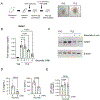Itaconate suppresses house dust mite-induced allergic airways disease and Th2 cell differentiation
- PMID: 39147278
- PMCID: PMC11967901
- DOI: 10.1016/j.mucimm.2024.08.001
Itaconate suppresses house dust mite-induced allergic airways disease and Th2 cell differentiation
Abstract
Itaconate was initially identified as an antimicrobial compound produced by myeloid cells. Beyond its antimicrobial role, itaconate may also serve as a crucial metabolic and immune modulator. We therefore examined the roles of aconitate decarboxylase 1 (Acod1) and itaconate in house dust mite (HDM)-sensitized and -challenged mice, a model of T helper 2 (Th2)-driven allergic airways disease. HDM treatment induced lung Acod1 mRNA expression and bronchoalveolar lavage (BAL) itaconate levels in wild-type C57BL/6 mice. Acod1 knockout mice (Acod1-KO) with negligible BAL itaconate showed heightened HDM-induced type 2 cytokine expression, increased serum IgE, and enhanced recruitment of Th2 cells in the lung, indicating a shift towards a more pronounced Th2 immune response. Acod1-KO mice also showed increased eosinophilic airway inflammation and hyperresponsiveness. Experiments in chimeric mice demonstrated that bone marrow from Acod1-KO mice is sufficient to increase type 2 cytokine expression in wild-type mice, and that restitution of bone marrow from wild type mice attenuates mRNA expression of Th2 cytokines in Acod1-KO mice. Specific deletion of Acod1 in lysozyme-secreting macrophages (LysM-cre+Acod1flox/flox) recapitulated the exaggerated phenotype observed in whole-body Acod1-KO mice. Adoptive transfer of Acod1-KO bone marrow-derived macrophages also increased lung mRNA expression of Th2 cytokines. In addition, treatment of Th2-polarized CD4 cells with itaconate impeded Th2 cell differentiation, as shown by reduced expression of Gata3 and decreased release of IL-5 and IL-13. Finally, public datasets of human samples show lower Acod1 expression in subjects with allergic asthma, consistent with a protective role of itaconate in asthma pathogenesis. Together, these data suggest that itaconate plays a protective, immunomodulatory role in limiting airway type 2 inflammation after allergen challenge by attenuating T cell responses.
Keywords: Aconitate decarboxylase 1; Allergen; Asthma; House dust mite; Itaconate; Macrophage.
Copyright © 2024 The Authors. Published by Elsevier Inc. All rights reserved.
Conflict of interest statement
Declaration of Competing Interest The authors declare that they have no known competing financial interests or personal relationships that could have appeared to influence the work reported in this paper.
Figures






References
MeSH terms
Substances
Grants and funding
LinkOut - more resources
Full Text Sources
Research Materials

